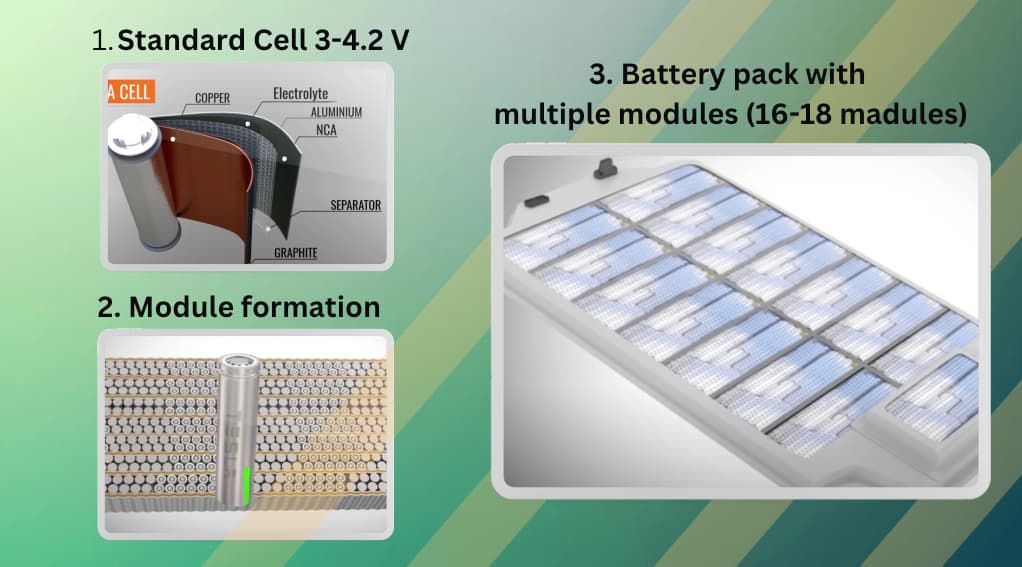Understanding EV batteries is essential as the electric vehicle (EV) revolution accelerates. One question often sparks curiosity among first-time buyers: What makes EV batteries tick? For those taking the leap into sustainable driving, understanding the beating heart of an EV is not just empowering but essential. EV batteries, primarily lithium-ion, are marvels of modern engineering that store and deliver energy efficiently, enabling the clean mobility that’s reshaping our world. With their blend of cutting-edge technology and environmental significance, these batteries encapsulate the innovation and sustainability that EV enthusiasts value most.
Why EV Batteries Matter
This article dives deep into the fascinating world of EV batteries. Understanding their functionality, maintenance, and future prospects not only enriches the ownership experience but also ensures that drivers make informed decisions about their vehicles and the broader implications of clean energy.
The Anatomy of an EV Battery
An EV battery’s anatomy may seem complex, but at its core, it’s a straightforward powerhouse. Lithium-ion cells, packed into modules, work in unison to store electricity and deliver it to the motor. These batteries boast high energy density, meaning they pack a significant amount of power into a relatively small space. For context, Tesla’s Model 3 battery pack—often a benchmark for performance—stores enough energy to power an average household for a few days.

Beyond their design, EV batteries are notable for their durability. Most automakers offer warranties covering 8 to 10 years or 100,000 miles, reflecting the industry’s confidence in their longevity. However, factors like temperature extremes, charging habits, and driving conditions can influence their lifespan. Drivers who embrace best practices, such as avoiding frequent rapid charging or maintaining moderate charge levels, often find their batteries lasting well beyond expectations.
Dispelling Myths About EV Batteries
But what about the myths that often shadow EV batteries? One common misconception is that EVs frequently suffer from “range anxiety,” where drivers worry about running out of power. While early EVs indeed struggled with limited range, modern models like the Hyundai Ioniq 6 or Ford Mustang Mach-E now offer ranges exceeding 300 miles per charge. This statistic comfortably addresses most daily commutes and even longer road trips. Coupled with the growing network of fast-charging stations—now over 50,000 in the U.S. alone—EV drivers are increasingly confident in their vehicles’ capabilities.
| Year | Vehicle Model | Approximate Range (miles) |
| 2011 | Nissan Leaf | 100 |
| 2012 | Tesla Model S | 265 |
| 2017 | Nissan Leaf | 168 |
| 2023 | Hyundai Ioniq 6 | 361 |
| 2023 | Tesla Model S | 405 |
Another prevalent myth revolves around environmental impact. Critics argue that EV batteries’ production and disposal negate their green benefits. While it’s true that mining materials like lithium and cobalt has ecological implications, the overall lifecycle emissions of EVs remain significantly lower than those of internal combustion engine vehicles. Moreover, advancements in battery recycling technologies are closing the loop, ensuring that materials can be recovered and reused, reducing reliance on virgin resources.
The Future of EV Batteries
The future of EV batteries is as electrifying as their present. Solid-state batteries, touted as the next frontier, promise even greater energy density, faster charging times, and enhanced safety. Companies like Toyota and QuantumScape are at the forefront of this innovation, with prototypes already demonstrating remarkable performance. Similarly, integration with renewable energy systems—such as solar-powered EV charging stations—is paving the way for truly sustainable mobility solutions.
For EV enthusiasts eager to explore more, EVGeek.com offers a treasure trove of resources. Dive into “The Top 5 New EVs You’ll Want to Drive in 2023” for insights into the latest models, or check out “How to Maximize the Battery Life of Your Electric Vehicle” for practical tips to keep your EV running at its peak. These guides, and many more, form part of our commitment to empowering readers with actionable knowledge about the rapidly evolving EV landscape.
In conclusion, understanding EV batteries is not merely about appreciating their technological brilliance but also recognizing their role in driving a cleaner, greener future. For first-time EV owners, this knowledge equips them to make the most of their vehicles while championing sustainability. With each new innovation, the promise of a fully electrified world comes closer, and every informed driver plays a part in this transformative journey.



